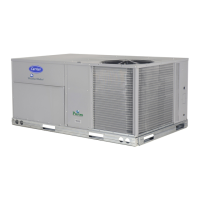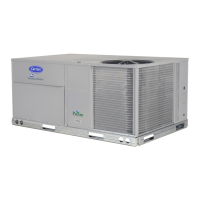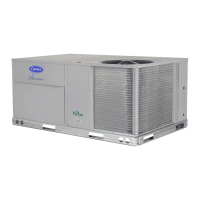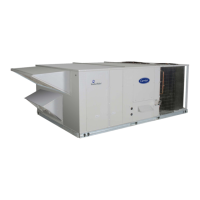69
PRE-- START--UP
PERSONAL INJURY HAZARD
Failure to follow this warning could result in personal
injury or death.
1. Follow recognized safety pract ices and wear
protec tive goggles when checking or servicing
refrigerant system.
2. Do not ope rate compressor or provide any electric
power to unit unless compressor terminal cover is
in place and secured.
3. Do not remove compressor terminal c over until
all electrical sources are disconnected.
4. Relieve all pressure from system before touching
or disturbing anything inside t erminal box if
refrigerant leak is suspected around compressor
terminals.
5. Never attempt to r epair soldered conne ction while
refrigerant system i s under pressure.
6. Do not use t orch to remove any component.
System contains oil and refrigerant unde r
pressure. To remove a component, wea r
protective goggles and proceed as follows:
a. Shut off electrical power and then gas to unit.
b. Recover refrigerant to relieve all pressure from
system using both high--pressure and low
pressure ports.
c. Cut component connection t ubing with tubing
cutter and remove component from unit.
d. Ca refully unsweat remaining tubing stubs
when nece ssary. Oil can ignite when exposed
to torch flame.
!
WARNING
ELECTRICAL OPERATION HAZARD
Failure to follow this warning could result in personal
injury or death.
The unit must be electrically grounded in accordance
with local codes and NEC ANSI/NFPA 70 (American
National Standards Institute/National Fire Protection
Association.)
!
WARNING
Proceed as follows to inspect and prepare the unit for
initial start--up:
1. Remove all access panels.
2. Read and follow instructions on all WARNING,
CAUTION, and INFORMATION labels attached to,
or shipped with, unit.
PERSONAL INJURY AND ENVIRONMENTAL
HAZARD
Failure to follow this warning could result in personal
injury or death.
Relieve pressure and recover all refrigerant before
system repair or final unit disposal.
Wear safety glasses and gloves when handling
refrigerants.
Keep torches and other ignition sources away from
refrigerants and oils.
!
WARNING
3. Make the following inspect ions:
a. Inspect for shipping and handling damages such
as broken lines, loose parts, or disconnected
wires, etc.
b. Inspect for oil at all refrigerant t ubing
connections and on unit base. Detecting oil
generally indicates a refrigerant leak. Leak--test
all refrigerant tubing connections using
electronic leak detector, halide torch, or
liquid--soap solution.
c. Inspect all field--wiring and factory--wiring
connec tions. Be sure that connections are
completed and tight. Be sure that wires are not
in contact with refrigerant tubing or sharp edges.
d. Inspect coil fins. If damaged duri ng shipping and
handling, carefully straighte n fins with a fin
comb.
4. Verify the following conditions:
a. Make sure that condenser--fan blade are corre ctly
positioned in fan orifice. See Condenser--Fan
Adjustment section for more details.
b. Make sure that air filter(s) is in place.
c. Make sure that condensate drain trap is filled
with water to ensure proper drainage.
d. Make sure that all tools and miscellaneous loose
parts have been removed.
START--UP, GENERAL
Unit Preparation
Make sure that unit has been installed in accordance with
installation instructions and a pplicable codes.
Gas Piping
Check gas piping for leaks.
48TC

